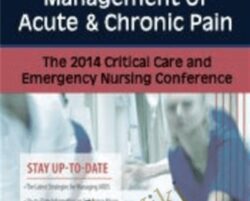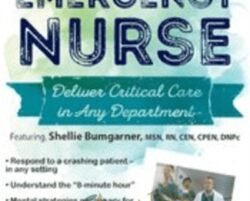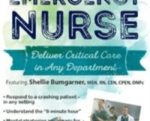Respond to a crashing patient – in any settingUnderstand the “8-minute hour”Mental strategies necessary for success in emergency situationsIncrease your confidence when handling deteriorating patientsYour coworker calls for help – you go in to see her patient, sitting up and talking just a few minutes ago, now turning blue and gasping for air. You have a real chance to intervene and make a difference – that’s why you became a nurse! What will you do?Imagine you are taking care of your patient – anywhere – the office, clinic, Nursing Home, OR, in the community and suddenly grasp that an emergency situation is unfolding. Do you know what to do? How to respond? Even if you call an ambulance or have a rapid response team coming, YOU may still be taking care of that patient for up to 8 minutes or more. What can YOU do in that time to improve the chances of a positive outcome?How will you help save lives?Your patient down the hall calls for help. As you enter the room, you see him begin to vomit blood. He becomes pale, and less responsive – but still awake. You call a Rapid Response, and stay with him until the team arrives. They assume care of the patient.You’re left wishing you had done more – he was your patient, after all.This intense course will provide you with the clinical insights and critical thinking skills that ED nurses excel at. You will no longer need to feel uncertain and scared.The ability to assess, intervene and advocate will be reinforced through exciting clinical cases. You will experience the dramatic changes in your own practice when you work your next shift!Develop a plan to respond to a crashing patient.Practice what is needed to respond quickly to help your sickest patients.Determine the immediate interventions necessary to save lives.Practice the mental strategies necessary for success.Distinguish between “sick” vs. “not sick”.Analyze clinical scenarios presented.Formulate a plan of action to deal with an emergency.How will you improve patient outcomes?Failure to rescue and how to avoid itIncreasing your confidence in emergent situationsPlanning for the worst at every patient encounterAdvocating for your patientCommunicating high-risk information clearlyMental strategies for successCognitive pre-planningHow the fire service relates to preparation for successRisk ReductionRecognizing risk for clinical declineHow to intervene before an eventWhy respiratory rate mattersKnow your strengths and have a plan to handle your weaknessesAssemble your teamCommon Emergency ConditionsThe steps you can take to save livesThe 3 highest priority interventions for eachCommon Emergency ConditionsCardiac ArrestChoking/Dislodged tracheostomyMajor TraumaControl of hemorrhageSepsisGI BleedNeurologyCVA/TIA: Acute Ischemic & HemorrhagicSeizureSubarachnoid bleedIntracranial hypertensionIs that blood pressure of 170/90 truly dangerous?CardiologyDysrhythmiasVentricular fibrillationVentricular tachycardia vs. AsystoleSVTRapid atrial fibrillation/flutterWhy is my patient tachycardic?Prioritization & PracticeWhat matters most when the patient crashesHow to practice every day in 2 minutes or lessWhy sick is sick until proven otherwiseTeam PreparationWho is coming to help you?Team dynamicsWhat if you’re alone?Cognitive ErrorWhich came first, the MI or the MVA?Don’t put the cart before the horsePutting it Together: Skills Lab & Clinical ScenariosGroup review of patient casesPractice with instructor feedbackUse of “preparation sheet”Tag: Think Like an Emergency Nurse: Deliver Critical Care in Any Department – Sean G. Smith Review. Think Like an Emergency Nurse: Deliver Critical Care in Any Department – Sean G. Smith download. Think Like an Emergency Nurse: Deliver Critical Care in Any Department – Sean G. Smith discount.
 The 8 Brocades – Flowing Zen
The 8 Brocades – Flowing Zen
 Stop the Hurt: Physiology & Management of Acute & Chronic Pain – Sean G. Smith
₹3,486.00
Stop the Hurt: Physiology & Management of Acute & Chronic Pain – Sean G. Smith
₹3,486.00
Think Like an Emergency Nurse: Deliver Critical Care in Any Department – Sean G. Smith
₹12,616.00





